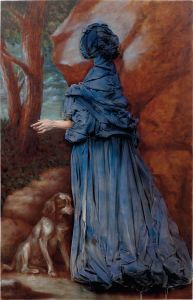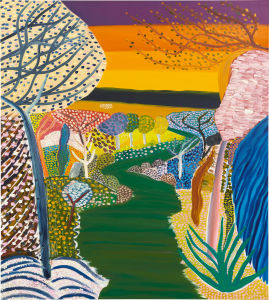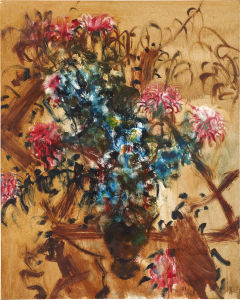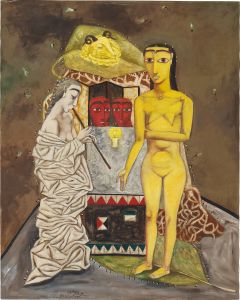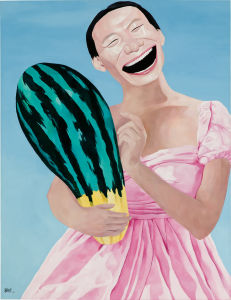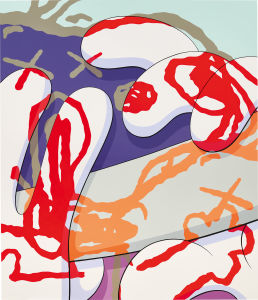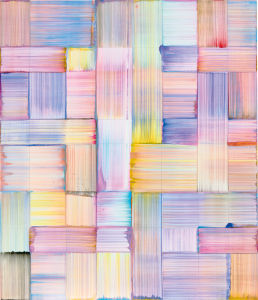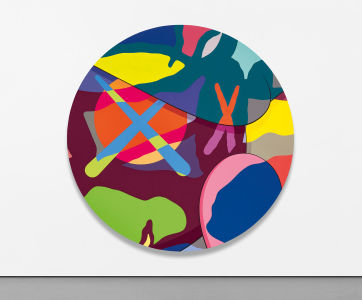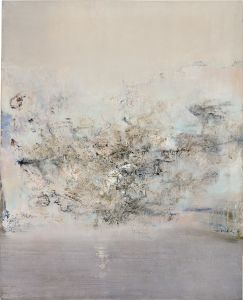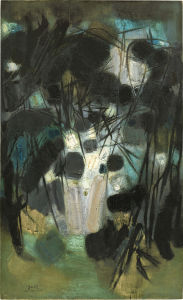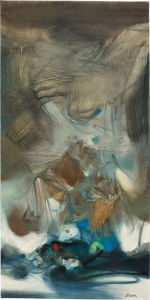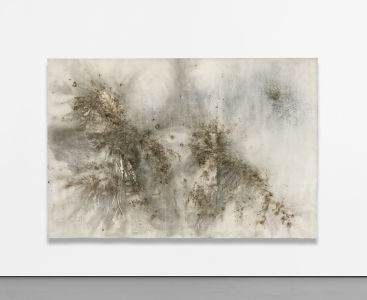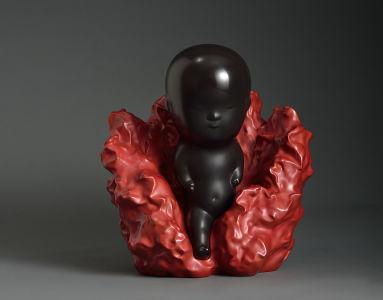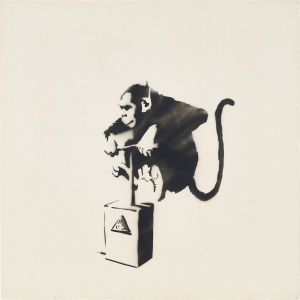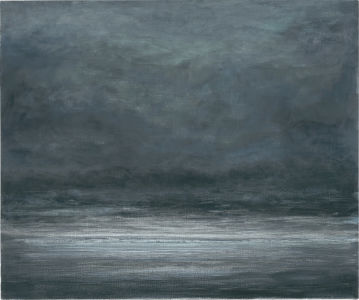
Introduction

The present painting in Yoshitomo Nara’s studio in Cologne, 1995 As one of the most beloved Japanese artists of our times, Yoshitomo Nara's practice has captured the hearts of a devoted audience worldwide. From followers to collectors, and art critics to institutions, the alluring charm of Nara's unparalleled oeuvre is universally understood and continues to grow, markedly establishing his position as a rock-star figure in the global art-historical canon. His most salient motif, a disgruntled yet endearing heroine whose childhood story is shared in repeated iterations throughout Nara's body of works, has become a global phenomenon, adored for her disproportionally large head with pudgy cheeks and almond-eyes that confront the viewer with a fixed, piercing stare.
Executed in 1995, a year considered to be paramount in Nara's practice, Hothouse Doll is an instantly compelling image that uniquely boasts the perfect amalgamation of traits that are iconic to Nara. Selected by the artist himself to rank among the distinguished 'Major Works' group that forefront his most extensive catalogue raisonné - of which nine others are now housed in permanent museum collections - it is Hothouse Doll that graces the publication's Volume I cover.

Yoshitomo Nara with the present work on the cover of his 2011 catalogue raisonné Hothouse Doll
Hothouse Doll is a quintessential Nara portrait, painted three years after graduating from his advanced degree under German painter A.R. Penck at the prestigious Kunstakademie Düsseldorf, the same year as his first published book of paintings, new representation with Blum & Poe, and a breakthrough solo show at Scai the Bathhouse in Tokyo which propelled him to international prominence.
Although the intriguing fusion of allegory and abstraction can be traced to the artist's early depictions of rosy-cheeked adolescents with intense gazes, it was during his pivotal years in Germany that he departed from vibrant tones and harsh outlines as his painterly technique refined. Inspired by artists that range from early Renaissance painters Giotto and Antonio del Pollaiuolo, Nara softened his palette to pastel hues and began removing any signifiers of setting from his compositions, thus establishing his signature style. A comparison can be drawn, for example, between the present painting and Giotto di Bondone’s Madonna and Child, circa 1320, where the subjects in each composition are depicted with softened flesh tones and a simplification of form against a background with no signifier of setting. Though the background in Bondone’s work was composed of thinly applied gold-leaf over a brown foundation which would illuminate when viewed under candlelight to symbolise the realm of heaven, the pastel wash Nara’s Hothouse Doll is situated within is impossibly born from numerous layers of chromatic underpainting. In a similar vein, the subtle execution and purity of line seen in Antonio del Pollaiuolo’s Profile Portrait of a Young Lady, 1465, highlights beautifully upon the features of the noblewoman in profile. Beyond the likeness in pigment colour – the baby-blue backdrop matching Hothouse Doll’s blue dress; the aristocrat’s ruby-red dress the same as Nara’s character’s lips; and with both subjects rendered with the same pearly hue – Nara’s delicate Renaissance-esque brushwork offers another distinct comparison between the two visual explorations of identity.

Antonio del Pollaiuolo, Profile Portrait of a Young Lady, 1465. Collection of the Gemäldegalerie, Berlin 
Giotto di Bondone, Madonna and Child, circa 1320. Collection of the National
Gallery of Art, Washington, D.C.
Antonio del Pollaiuolo, Profile Portrait of a Young Lady, 1465. Collection of the Gemäldegalerie, Berlin 
Giotto di Bondone, Madonna and Child, circa 1320. Collection of the National
Gallery of Art, Washington, D.C.
The present work exquisitely portrays Nara's craft at its best, presenting the full figure of a small child with a sullen mouth sitting in a milky mass that initially resembles an off-white wash. Up close, however, a complex layering of textured brushstrokes is revealed, with hints of colour that tease the eye in a game of hide-and-seek that have been applied in such a meticulous manner it echoes the Old Masters and 20th-century painting giants. Bringing the protagonist into fuller focus against the cloudy backdrop through the employment of a simplistic pictorial framework that is reminiscent of traditional Japanese ukiyo-e woodblock prints, Nara transcends the limits of time and place.

Kitagawa Utamaro, Kasen Koi no Bu, circa 1793. Collection of the Museum of Fine Arts, Boston The contrast between the protagonist of Hothouse Doll’s blue dress set against a background that is shrouded in white emphasises her isolation; however, her gaze is defiant and determined, suggesting an indifference to her own fragility as she refuses to surrender to it. Triggering a universal maternal instinct in the viewer, the child glares at us with an almost silent accusation against a world that could leave them so alone.
"Nara’s roly-poly children balance on the razor’s edge: they are cute embodiments of infantilism in their chubby-cheeked plumpness […] but at the same time true individuals who will not be defeated, quiet carriers of hope." —Stephan Trescher
'So lonely and only surrounded by apple trees'
To understand this profound ability of Nara's to give form to sensitivity, one must first turn to the artist's past, to a childhood 'so lonely and only surrounded by apple trees' i. Born in 1959, in post-world war II Hirosaki, Nara's surroundings were 'filled with debris and ghosts' ii. The youngest child of working parents, he spent much of his time in solitude with little to do but explore the depths of his imagination. To entertain himself, his early visual stimuli came 'from television, from Japanese and American comic books, and from European children's books' iii, citing Aesop's Fables, Hans Christian Anderson fairy-tales and Brothers Grimm as some of his favourites. Drawing influence from story and comic book illustrations in his cartoon-esque renderings in acrylic on canvas, Nara seamlessly bridges 'high, low and kitsch; East and West; grown-up, adolescent and infantile' iv. As esteemed critic Roberta Smith asserts, this revolutionary unification positions Nara as 'one of the most egalitarian visual artists since Keith Haring' iv, attracting 'many people, because they recognise their precious inner solitude within [his works]' v giving ‘each of us a sudden urge of nostalgia' v, as further concurred by novelist Banana Yoshimoto.
In Wonderland
Like comic book heroes whose never-changing appearances become ingrained in the minds of readers, Nara paints the same face over and over again - so much so that his cast of recalcitrant characters have become so iconic, instantly recognisable as the artist's own. Although slight alterations gradually set in - such as the cherished wide doe-eyes and bob haircut in the present painting that are characteristic of his works from the 90s and paved the way into his style in the 2000s – the viewer is always met with a distinctively Nara face.
A distinguishing feature of the present work, however, is the doll-like child in a baby blue dress with a peter-pan collar that appears only sporadically throughout the 90s. A rarer rendition than her ruby-red counterpart, whom is often depicted in a more violent manner with a weapon in hand, the blue-dressed girl juxtaposes with extreme innocence and purity that draws a comparison to both the adventures of Alice in Wonderland as well as Kenji Miyazawa's ‘symbolic use of the colours blue, white and gold to indicate transcendence’ vi and the lightness of childhood in his children's literature.
Miyazawa's books were of the collection Nara brought from home to turn to in Germany, 'when winter came and leaden clouds filled the skies [and he] found [himself] slipping back to the winters of [his] childhood' vii. Straddling the universal themes of rebellion, vulnerability, anxiety, and youthful imagination, a psychological complexity imbues Nara's world that not only reflects the artist's own experiences, it evokes the viewer's own memories as they are powerfully transported back into the internal world of the child.
It Started with Music
"If viewers are able to see beyond the impulsive and surface-level impact of [my] work, and sense a moving quietude and depth, then, no doubt, these effects are influenced by such music." —Yoshitomo Nara
Nara’s love of music is so deeply ingrained into his psyche that it readily leads him to his creativity, directly and indirectly manifesting into his work. At the age of eight, Nara built himself a radio which would become a treasured companion, helping him to understand he belonged to a wider world. Tuning into the music station of a nearby US Air Force base in Misawa, Nara unwittingly became an improbable witness to Western pop’s evolution from the flower-child bliss of the mid-60s, to the rock n’ roll attitude of 70s punk. Seeking refuge and inspiration, music connected Nara to the redefining spirit of a new generation. Although he did not understand the lyrics of the anti-establishment songs of this era, he found the spirit of individual liberation inspirational, and the record covers ‘the first things that spoke to [him] as works of visual art’ viii. The visual energy of the colours, graphics and exoticism of foreign bands on album’s sleeves offered Nara an unorthodox art education, yet this connection to the atmospheric power of music is undeniably found in the formal properties of Nara’s works.

Neil Young
On the Beach, 1974
Click to listen on SpotifyWhen asked to name a person of great importance to him, Nara chose musician Neil Young, stating ‘he is my all-time favourite’ xi. Like the children in Nara’s body of works whose defiant attitudes signify their fierce independence, Young’s music has been celebrated for its spirit of equality and freedom.

Joni Mitchell
Clouds, 1969
Click to listen on SpotifyDescribing Joni Mitchell as ‘someone who is the epitome of “a person who chose expression” ix, Nara has praised the singer and songwriter for her painterly abilities in creating her own album art. Like Hothouse Doll, Mitchell’s cover art situates a figure at the centre of the composition who is rendered with a confident attention to detail in a multi-layered approach.

Mark Fry
Dreaming with Alice, 1972
Click to listen on SpotifyBeyond the album’s title which like the present painting, brings to mind Lewis Carroll’s Alice’s Adventures in Wonderland, this acid-folk album within Nara’s collection presents light acoustic sounds that blend the ethereal and childlike with the haunted, such as Nara’s seemingly cute yet also somewhat sinister portraits.

Gene Parsons
Kindling, 1973
Click to listen on SpotifyAlthough the sound of this album is comfortable country rock, Nara found the creator to be ‘not as carefree as [he] may have thought’ x. Upon opening the album sleeve, the kind smiling man on the front opens up to a more violent image of tree stumps cut down. This juxtaposition is undeniably reminiscent of Nara’s exploration of the edge between good and evil.

Gregg Allman
Laid Back, 1973
Click to listen on SpotifyAnother album within Nara’s collection whose cover art presents a curious juxtaposition is that of Gregg Allman’s 1973 southern rock album, Laid Back. Looking through the windows of the room, we see the singer’s face; however, in the distance behind him is billowing smoke indicating a sense of danger that is far from the album title suggests.

Neil Young
On the Beach, 1974
Click to listen on SpotifyWhen asked to name a person of great importance to him, Nara chose musician Neil Young, stating ‘he is my all-time favourite’ xi. Like the children in Nara’s body of works whose defiant attitudes signify their fierce independence, Young’s music has been celebrated for its spirit of equality and freedom.

Joni Mitchell
Clouds, 1969
Click to listen on SpotifyDescribing Joni Mitchell as ‘someone who is the epitome of “a person who chose expression” ix, Nara has praised the singer and songwriter for her painterly abilities in creating her own album art. Like Hothouse Doll, Mitchell’s cover art situates a figure at the centre of the composition who is rendered with a confident attention to detail in a multi-layered approach.
Known to appropriate song lyrics in the titles of his works, perhaps Hothouse Doll, too, derives from a musical source, such as that of Bruce Hornsby’s 1995 album Hot House featuring songs boasting socially conscious lyrics with darker underlying messages, similar to the tension present between opposing elements in Nara’s compositions. Meanwhile, another link can be made between the name of Nara’s series of which this painting forms part of, ‘in the White Room’, and the iconic song White Room (1968) by British rock band Cream, which speaks about a transitional, watershed period where the writer, living in a white room, came to terms with momentous changes in his life – an echo of Nara’s own life at the time of creating this work. Further, the whimsical harmony of colour and texture in the present work brings to mind the melodic simplicity of indie-folk; yet contrastingly, the mischievous child’s expression exudes a certain punk energy. This work contains the indelible imprint not only of Nara’s idiosyncratic creativity, but also of his own unique life.

Cream
White Room, 1968
Click to listen on SpotifyAn unrivalled exemplar of historical significance in Nara’s prolific oeuvre, Hothouse Doll showcases the artist’s accomplished painterly phenomenon in its full effect. His flawless depiction of a sweet but bellicose youth against a soft, sensual background of layered pastel impasto exquisitely speaks to Nara’s remarkable talent in rendering such a seemingly simple subject, born from his young creativity and critical years abroad. Both naïve and wise, the complex emotions that can be read on her face indicates a more profound set of meanings that awakens the imagination of the viewer, tantalising our senses in an all-encompassing manner that has become both renowned and paradigmatic within the contemporary art visual lexicon.
Collector’s Digest
With an incomparable painting style that remains highly sought after and revered throughout his career, Nara has been honoured with extensive solo exhibitions in prominent institutions around the globe. Works of his form part of over sixty public collections and his prestige is to be celebrated once again in an upcoming international retrospective planned by The Los Angeles County Museum of Art, where the survey will be presented before travelling to Shanghai’s Yuz Museum, Museo Guggenheim Bilbao and the Kunsthal Rotterdam.
i Yoshitomo Nara quoted in Aimee Lin, ‘Yoshitomo Nara’, ArtReview, 14 September 2015, online
ii Yeewan Koon, Yoshitomo Nara, New York, 2020, p. 12
iii Yoshitomo Nara quoted in Stephan Trescher, ‘My Superficiality is Only a Game’, Lullaby Supermarket, exh. cat., Würzburg, 2002, p. 104
iv Roberta Smith, ‘Cuddling With Little Girls, Dogs and Music’, The New York Times, 9 September 2010, online
v Banana Yoshimoto, ‘The World of Nara-kun’, in Yoshitomo Nara: The Complete Works Volume I: Paintings, Sculptures, Editions, Photographs, eds. Noriko Miyamura and Shinko Suzuki, Tokyo, 2011, p. 9
vi Midori Matsui, ‘A Child in the White Field: Yoshitomo Nara as a Great ‘Minor’ Artist’, in Yoshitomo Nara: The Complete Works Volume I: Paintings, Sculptures, Editions, Photographs, eds. Noriko Miyamura and Shinko Suzuki, Tokyo, 2011, p. 341
vii Yoshitomo Nara, ‘Nobody’s Fool’, in Yoshitomo Nara: The Complete Works Volume I: Paintings, Sculptures, Editions, Photographs, eds. Noriko Miyamura and Shinko Suzuki, Tokyo, 2011, p. 44
viii Yoshitomo Nara in Michael Govan, ‘Foreword’, in Yoshitomo Nara, ed. Claire Crighton, Los Angeles, 2020, p. 6
ix Yoshitomo Nara, ‘In My Teens, I Studied Art Through Record Jackets’, in Yoshitomo Nara, ed. Claire Crighton, Los Angeles, 2020, p. 117
x Yoshitomo Nara, ‘In My Teens, I Studied Art Through Record Jackets’, in Yoshitomo Nara, ed. Claire Crighton, Los Angeles, 2020, p. 118
xi Yoshitomo Nara quoted in Aimee Lin, ‘Yoshitomo Nara’, ArtReview Asia, 14 September 2015, online
Provenance
Gallery Hakutosha, Nagoya
Private Collection
Christie's, New York, 14 May 2008, lot 334
Acquired at the above sale by the present ownerExhibited
Nagoya, Gallery Hakutosha, Yoshitomo Nara: Hothouse Fresh, 20 January - 24 February 1996, p. 17 (illustrated)
Seoul, National Museum of Contemporary Art, Japanese Contemporary Art Exhibition, September - October 1997, p. 132 (illustrated)
Nagoya, Parco Gallery, Done, Did, 3 - 30 December 1999
Yokohama Museum of Art; Ashiya City Museum of Art & History; Hiroshima City Museum of Contemporary Art; Hokkaido Asahikawa Museum of Art; Hirosaki, Yoshii Brick Brewhouse, Nara Yoshitomo: I DON'T MIND, IF YOU FORGET ME., 11 August 2001 - 29 September 2002, no. 21, p. 127 (illustrated)
Tokyo, Parco Museum, Girls Don't Cry, 26 April - 26 May 2003, p. 45 (illustrated)
Mito, Museum of Modern Art Ibaraki, Kazoku no jokei: Nihon no kazouku wo kangaeru, September - November 2006, p. 127, pl. 103 (illustrated)Literature
Yoshitomo Nara: In the Deepest Puddle, Tokyo, 1997, n.p. (illustrated)
Bijutsu Techo Monthly Art Magazine, vol.52, no.790, July 2000, p. 82 (illustrated)
Yoshitomo Nara: Lullaby Supermarket, exh. cat., Institut für Kunst Nürnberg, 2002, pp. 37, 191 (illustrated)
Noriko Miyamura and Shinko Suzuki, eds., Yoshitomo Nara: The Complete Works Volume 1: Paintings, Sculptures, Editions, Photographs 1984-2010, Tokyo, 2011, no. P-1995-001, front cover, title page, pp. 21, 112 (illustrated)
Bijutsu Shuppan-Sha, ed., Yoshimoto Nara: The Complete BT Archives 1991-2013, Tokyo, 2013, pp. 156, 460, 536-539 (illustrated)
Dominique Chan and Fumio Nanjo, eds., Once in a Life - Encounters with Nara, Hong Kong, 2016, fig. 10, 14, pp. 24, 38 (illustrated)
Property of an Important Private Collector
Ο◆✱5
Hothouse Doll
1995
titled "Hot House Doll. (in the white room - III)" on the reverse
acrylic on canvas
119.8 x 109.9 cm. (47 1/8 x 43 1/4 in.)
Painted in 1995.
Estimate
HK$50,000,000 - 70,000,000
€6,200,000-8,680,000
$6,410,000-8,970,000
Sold for HK$103,115,000
Charlotte Raybaud
Head of Evening Sale, 20th Century & Contemporary Art
20th Century & Contemporary Art Evening Sale in Association with Poly Auction
Hong Kong Auction 3 December 2020
32
This lot is no longer available.


